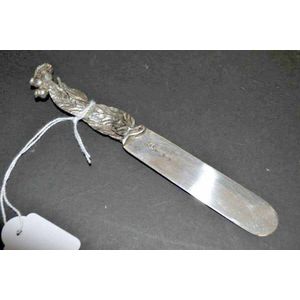Ancient Chinese Bronze Dagger with Horse Handle and Shaft
You must be a subscriber, and be logged in to view price and dealer details.
Subscribe Now to view actual auction price for this item
When you subscribe, you have the option of setting the currency in which to display prices to $Au, $US, $NZ or Stg.
- Bronze - An alloy of copper and tin, traditionally in the proportions of about 9 parts of copper to 1 part of tin.
The discovery of bronze in Western Asia in the 4th century enabled people to create metal objects which were superior to those previoulsy possible because of its strength and hardness, and it has been used throughout the world for weapons, coins, tools, statuary and other decorative items.
It is very fluid in a molten state, and its hardness, strength when set, and non-corrosive properties makes it most suitable for casting sculpture. - Patination / Patina - In broad terms, patination refers to the exterior surface appearance of the timber, the effect of fading caused by exposure to sunlight and air over the course of a century or more, changing the piece to a soft, mellow colour.
As patina is very difficult to replicate, it is one of the most important guides to determining the age of furniture.
Patina is also the term applied to the bloom or film found on old bronzes due to oxidisation. - Malachite - Malachite is bright copper-green coloured stone with concentric layers which displays distinct contrasting veinings. It has been valued in the past for making or decorating small precious objects such as clocks, jewellery, dishes and so. In the Orient it was used for snuff bottles and in Russia and was favoured by the Faberge workshop. larger pieces were used for table tops.
The principal source of supply was Russia but it is to be found in other regions such as Southern Africa, Mexico, Australia and France.
Malachite glass is a manufactured material that was intended to resemble malachite, but often bears more resemblance to a veined coloured marble due to its lower gloss finish and lack of concentric layers. Malachite glass was manufactured by many glassworks in the 19th century including Loetz in Austria and others in Bohemia and Davidson's Greener's and Sowerby in north eastern England.
It was particularly used for scent bottles, bowls, and small vases often decorated with nymphs.
Malachite glass has been manufactured continuously since the late nineteenth century, most is unmarked and it is difficult to distinguish the age or manufacturer of most commercial pieces.
This item has been included into following indexes:
Visually similar items

World War I German Erfurt mint bayonet single edge fullered blade with matching steel scabbard

Luristan small bronze double edged fighting sword, good excavation example, shows battle cuts to one side. Condition: Wear consistent with age, large hole to end of handle, length of blade 27 cm,

Sterling silver letter opener with gum leaf handle by Zigmunt Libucha

Chinese bronze ceremonial sword with inscriptions
